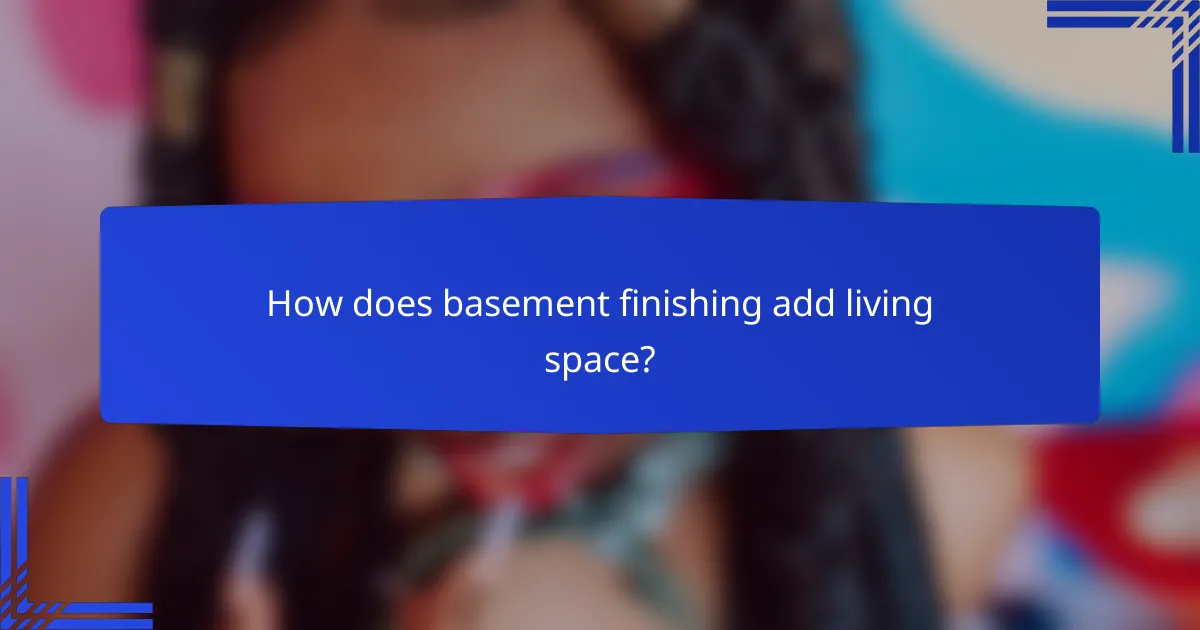Basement finishing is an effective way to convert an underutilized area into valuable living space, enhancing both comfort and functionality in your home. This transformation not only increases the overall square footage but also significantly boosts property value, making it a smart investment for homeowners. With a range of design options available, you can create a space that perfectly fits your lifestyle, whether for leisure, work, or fitness.

How does basement finishing add living space?
Basement finishing transforms an unfinished area into usable living space, significantly increasing the overall square footage of a home. This process not only enhances comfort but also boosts property value by creating additional rooms tailored to various needs.
Increased usable area
Finishing a basement effectively converts a previously underutilized area into functional space. Homeowners can expect to gain anywhere from 300 to 1,000 square feet of usable area, depending on the basement’s size and layout. This added space can be used for a variety of purposes, from recreational rooms to guest suites.
When planning for increased usable area, consider the ceiling height and layout. Local building codes may dictate minimum ceiling heights, typically around 7 feet, which can affect how the space is utilized.
Flexible room configurations
One of the key advantages of a finished basement is the flexibility in room configurations. Homeowners can design the space to meet their specific needs, whether that’s a home office, gym, or playroom. The open layout often found in basements allows for creative designs that can adapt over time.
Consider using movable partitions or furniture to create multi-functional spaces. This adaptability can be particularly beneficial for families who may need to change the room’s purpose as their needs evolve.
Enhanced functionality
Finishing a basement enhances its functionality by incorporating features that improve livability. This can include adding bathrooms, kitchens, or laundry facilities, which make the space more self-sufficient. Such improvements not only increase convenience but also appeal to potential buyers.
When enhancing functionality, prioritize natural light and ventilation. Installing egress windows can provide necessary light and meet safety regulations, making the space more inviting and compliant with local building codes.

What is the impact of basement finishing on property value?
Finishing a basement can significantly enhance property value by transforming unused space into livable areas. This improvement often leads to a higher resale price and a more appealing home for potential buyers.
Higher resale value
A finished basement can increase a home’s resale value by a notable percentage, often ranging from 10% to 20% depending on the local market. Homebuyers typically view a finished basement as an added asset, making the property more competitive.
Investing in quality finishes can yield a higher return on investment. For example, spending around $20,000 to $50,000 on a basement renovation may result in an increase of $30,000 to $70,000 in property value, depending on the area.
Attracts potential buyers
A finished basement attracts potential buyers by providing additional living space that can be used for various purposes, such as a guest suite, home office, or entertainment area. This versatility appeals to families and individuals looking for functional homes.
In markets where space is limited, a finished basement can be a key selling point. Buyers often prioritize homes with extra rooms, making your property stand out in listings and viewings.
Improved marketability
Finishing a basement improves marketability by enhancing the overall appeal of the home. Well-designed basements can showcase creativity and functionality, making the property more attractive during showings.
To maximize marketability, ensure the basement is well-lit, properly ventilated, and decorated in neutral tones. These features can help potential buyers envision themselves in the space, increasing the likelihood of a sale.

What design options are available for basement finishing?
Basement finishing offers a variety of design options that can transform an underutilized space into a functional area. Homeowners can choose from styles that suit their needs, whether for relaxation, work, or exercise.
Modern minimalist styles
Modern minimalist styles emphasize simplicity and functionality, making them ideal for basements. This design often features clean lines, neutral color palettes, and uncluttered spaces, which can create a sense of openness.
To achieve a minimalist look, consider using built-in furniture and open shelving. Materials like concrete, glass, and metal can enhance the modern aesthetic while keeping maintenance low.
Cozy family rooms
Cozy family rooms in basements provide a warm and inviting atmosphere for gatherings. Soft furnishings, warm lighting, and personal touches like family photos can make the space feel welcoming.
Incorporating a sectional sofa, a coffee table, and a media center can create a perfect setup for movie nights. Adding rugs and curtains can further enhance comfort and warmth in the room.
Home offices and gyms
Transforming a basement into a home office or gym can maximize its utility. A dedicated workspace can improve productivity, while a gym offers convenience for fitness enthusiasts.
For a home office, ensure good lighting and ergonomic furniture. In contrast, a gym should have durable flooring and enough space for equipment. Consider soundproofing if noise is a concern, especially for home offices.

What are the costs associated with basement finishing in the UK?
The costs of basement finishing in the UK can vary significantly based on several factors, including the size of the space and the complexity of the design. Generally, homeowners should expect to invest anywhere from several thousand to tens of thousands of pounds to transform their basements into functional living areas.
Average cost per square foot
The average cost for finishing a basement in the UK typically ranges from £50 to £100 per square foot. This price can fluctuate based on the quality of materials chosen and the level of customization desired. For example, a basic finish may cost closer to the lower end, while high-end finishes with intricate designs could reach the upper range.
Factors affecting pricing
Other factors include the choice of finishes, such as flooring, wall treatments, and fixtures. Custom designs or high-end materials will drive up the price, while standard options can help keep costs manageable. Local labor rates and any necessary permits or inspections can also impact the final budget.
Potential return on investment

What are the prerequisites for basement finishing?
Before finishing a basement, it’s essential to understand the prerequisites that ensure a successful project. Key considerations include compliance with building codes, effective moisture control, and proper electrical and plumbing setups.
Building codes and permits
Adhering to local building codes is crucial for basement finishing. These regulations dictate safety standards and ensure that the finished space is habitable. Before starting, check with your local municipality to determine the necessary permits and inspections required for your project.
Common permits may include those for structural changes, electrical work, and plumbing installations. Failing to obtain the correct permits can lead to fines and complications during the sale of your property.
Moisture control measures
Moisture control is vital in basement finishing to prevent mold growth and structural damage. Start by assessing the existing moisture levels and consider installing a dehumidifier if necessary. Waterproofing the walls and floors can also help mitigate moisture issues.
Additionally, ensure proper drainage around the foundation and consider using vapor barriers on walls and floors. Regularly inspect these areas to maintain a dry environment and protect your investment.
Electrical and plumbing considerations
When finishing a basement, electrical and plumbing systems must meet safety standards and functionality requirements. Consult a licensed electrician to ensure that the electrical layout supports your intended use, including adequate outlets and lighting.
For plumbing, consider the placement of bathrooms or wet bars, and ensure that drainage and water supply lines are properly installed. Hiring professionals for these installations can prevent costly mistakes and ensure compliance with local codes.

How to choose a contractor for basement finishing?
Selecting the right contractor for basement finishing is crucial for ensuring quality work and a successful project. Focus on experience, reputation, and clear communication to make an informed choice.
Evaluating contractor experience
When evaluating contractor experience, consider their years in the business and the number of basement projects they have completed. A contractor with a solid track record in basement finishing is more likely to deliver high-quality results.
Ask for references or case studies of previous projects. This can provide insight into their craftsmanship and ability to meet deadlines. Look for contractors who specialize in basement renovations, as they will be familiar with common challenges and solutions.
Additionally, check if the contractor is licensed and insured, which is essential for protecting yourself from liability. In the U.S., most states require contractors to have specific licenses for home renovations, including basement finishing. Always verify their credentials before making a decision.
